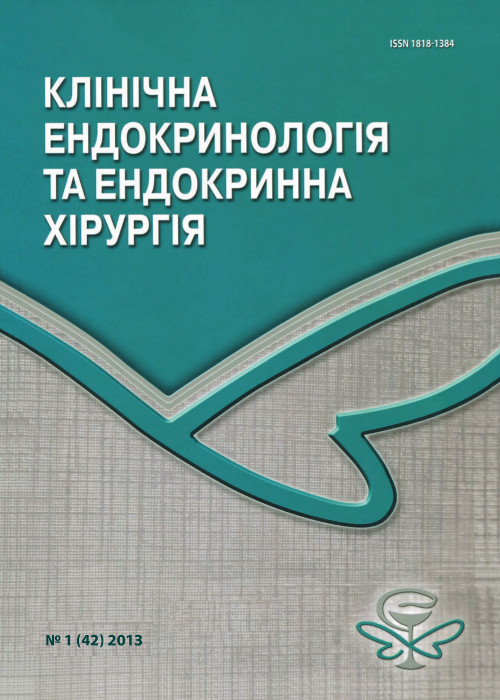Ідіопатична низкорослість: клініко-діагностичні критерії
DOI:
https://doi.org/10.24026/1818-1384.1(42).2013.77461Ключові слова:
idiopathic short stature, clinical and diagnostic criteria, children and adolescentsАнотація
This article focuses on current diagnostic criteria and clinical features patients with idiopathic short stature (ISS). According our data, part of such patients is 26.6% among patients with growth retardation referred to paediatric endocrinologist. We studied 41 cases of ISS (58.5% males). Familial history have 65.8% patients. Children have normal birth length and weight; without severe somatic, endocrine or genetic abnormalities. Patients showed height's delay from minus1.5 to minus 3.5 SD. Decreased of growth velocity accompanied with delay of the timing of puberty, negative adverse psychological and educational consequences. Pubertal patients showed higher levels of internalizing behaviour, lower levels of externalizing behaviour and selfesteem. Bone age delay was not more than 3 years in 90.24% children. GH peak >10 ng/ml was seen in 46.34% patients during two tests (with insulin and clonidin) and in 53.65% patients during one of the tests. IGF-1 levels were within the normal range. Children with idiopathic short stature may have some degree of GH insensitivity in IGF-I-producing tissue. Assessment of psychological status should be included in future research and in the current clinical care of patients with ISS.
Посилання
Noeker M. Management of idiopathic short stature: psychological endpoints, assessment strategies and cognitive-behavioral intervention / M. Noeker // Horm Res. – 2009. – N 1. – P. 75-81. https://doi.org/10.1159/000178044
ISS Consensus Workshop participants Consensus Statement on the Diagnosis and Treatment of Children with Idiopathic Short Stature: A Summary of the Growth Hormone Research Society, the Lawson Wilkins Pediatric Endocrine Society, and the European Society for Paediatric Endocrinology Workshop / P. Cohen, A. D. Rogol, C.L. [et al.] // J. Clin. Endocrinol. Metab. – 2008. – Vol. 93. – N. 11. – P. 4210-4217. https://doi.org/10.1210/jc.2008-0509
Idiopathic short stature: definition, epidemiology, and diagnostic evaluation / J.M. Wit, P.E. Clayton, A.D. Rogol [et al.] // Growth Horm. IGF Res. – 2008. – Vol.18. – P. 89-110. https://doi.org/10.1016/j.ghir.2007.11.004
Idiopathic short stature: management and growth hormone treatment / J.M. Wit, E.O. Reiter, J.L. Ross [et al.] // Growth Horm IGF Res. – 2008. – Vol. 18. – P. 111-135. https://doi.org/10.1016/j.ghir.2007.11.003
Ranke M.B. Towards a consensus on the definition of idiopathic short stature / M.B. Ranke // Horm Res. – 1996. – Vol. 45 (Suppl. 2). – P. 64-66. https://doi.org/10.1159/000184851
Binder G. Identification of short stature caused by SHOX defects and therapeutic effect of recombinant human growth hormone / G. Binder, C.P. Schwarze, M.B. Ranke // J. Clin. Endocrinol. Metab. – 2000. – N 85 (1). – P. 245-249. https://doi.org/10.1210/jcem.85.1.6375
Hujeirat Y. Growth hormone receptor sequence changes do not play a role in determining height in children with idiopathic short stature/ Y. Hujeirat, O. Hess, S. Shalev, Y. Tenenbaum-Rakover // Horm. Res. – 2006. – N 65 (4). – P. 210-216. https://doi.org/10.1159/000092514
Goddard A.D. Mutations of the growth hormone receptor in children with idiopathic short stature. / A.D. Goddard, R. Covello, S.M. Luoh [et al.], the Growth Hormone Insensitivity Study Group // N. Engl. J. Med. – 1995. – N 333 (17). – P. 1093-1098. https://doi.org/10.1056/nejm199510263331701
Attie K.M. Evidence for partial growth hormone insensitivity among patients with idiopathic short stature. The National Cooperative Growth Study / K.M. Attie, L.M. Carlsson, A.C. Rundle, B.M. Sherman // J. Pediatr. – 1995. – N 127 (2). – P. 244-250. https://doi.org/10.1016/s0022-3476(95)70302-0
Utah Growth Study: growth standards and the prevalence of growth hormone deficiency / R. Lindsay, M. Feldkamp, D. Harris [et al.] // J. Pediatr. – 1994. – Vol.125. – P.29-35. https://doi.org/10.1016/s0022-3476(94)70117-2
Hermanussen M. The calculation of target height reconsidered / M. Hermanussen, J. Cole // Horm. Res. – 2003. – Vol. 59. – P. 180-183. https://doi.org/10.1159/000069321
Luo Z.C. Target height as predicted by parental heights in a population-based study / Z.C. Luo, K. Albertsson-Wikland, J. Karlberg // Pediatr. Res. – 1998. – Vol. 44. – P. 563-571. https://doi.org/10.1203/00006450-199810000-00016
Centers for Disease Control CDC growth charts: United States. – 2000. – http://www.cdc.gov/growthcharts/
World Health Organization. The WHO child growth standards. – 2008. – http://www.who.int/childgrowth/en/
Cianfarani S. Naccuracy of insulin-like growth factor (IGF) binding protein (IGFBP)-3 assessment in the diagnosis of growth hormone (GH) deficiency from childhood to young adulthood: association to low GH dependency of IGF-II and presence of circulating IGFBP-3 18-kilodalton fragment / S. Cianfarani, A. Liguori, S. Boemi [et al.] // J. Clin. Endocrinol. Metab. – 2005. – Vol. 90. – P. 6028-6034. https://doi.org/10.1210/jc.2005-0721
Psychological adaptation in children with idiopathic short stature treated with growth hormone or placebo / J.L. Ross, D.E. Sandberg, S.R. Rose [et al.] // J. Clin. Endocrinol. Metab. – 2004. – Vol. 89. – P. 4873-4878. https://doi.org/10.1210/jc.2004-0791
Improvements in behaviour and self-esteem following growth hormone treatment in short prepubertal children / J.E. Chaplin, B. Kristrom, B. Jonsson [et al.] / Horm. Res. Paediatr. – 2011. – Vol. 75 (4). – P. 291-303. https://doi.org/10.1159/000322937
Quality of life of young adults with idiopathic short stature: effect of growth hormone treatment. Dutch Growth Hormone Working Group / L.T. Rekers-Mombarg, J.J. Busschbach, G.G. Massa [et al.] / Acta Paediatr. – 1998. – Vol. 87 (8). – P. 865- 870. https://doi.org/10.1111/j.1651-2227.1998.tb01553.x
Long-term psychosocial consequences of hormone treatment for short stature / H. Visser-van Balen, R. Geenen, G.A. Kamp [et al.] // Acta Paediatr. – 2007. – Vol. 96. – P. 715-719. https://doi.org/10.1111/j.1651-2227.2007.00235.x
Sandberg D.E. Growth hormone treatment of short stature: status of the quality of life rationale / D.E. Sandberg, M. Colsman // Horm. Res. – 2005. – Vol. 63. – P. 275-283. https://doi.org/10.1159/000086593
Allen D.B. Growth hormone for short stature: ethical issues raised by expanded access / D.B. Allen, N.C. Fost // J. Pediatr. – 2004. – Vol. 144. – P. 648-652. https://doi.org/10.1016/s0022-3476(04)00158-1
##submission.downloads##
Опубліковано
Номер
Розділ
Ліцензія
Авторське право (c) 2013 Клінічна ендокринологія та ендокринна хірургія

Ця робота ліцензується відповідно до Creative Commons Attribution-NonCommercial 4.0 International License.





